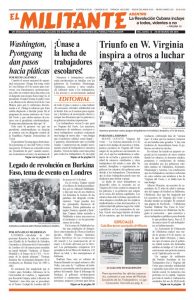SEATTLE — Debate continues in Washington state over who is responsible for the derailment of Amtrak’s maiden voyage over new track between Tacoma and Portland, Oregon, that led to the death of three people and injured dozens Dec. 18. While Amtrak bosses insinuate that the train’s engineer was responsible, inadequate training, management’s hurry to get the service going to generate income and the bosses’ disregard for safety lay behind the disaster.
“There’s still a lot more that will come out concerning the derailment,” John Hiatt, a former Burlington Northern Santa Fe engineer and 25-year veteran railroad accident investigator for the Bremseth Law firm in Minnesota, told the Militant. Hiatt lives in Washington and has talked to Amtrak workers there about the accident. “A big concern is that the engineer had only one trip on the throttle in the southbound direction and that was at night.”
The National Transportation Safety Board released an interview with the unnamed engineer. He said he had no reservation about his readiness to make the run, that he had operated the equipment on three training runs — one southbound and two going north. He said he knew there was a sharp curve and speed reduction after milepost 18, but that he didn’t see the sign.
He said the fact that there was a conductor training on the run on the engine with him didn’t distract him. When he did see a sign posted 30 mph he jammed on the brake, but it was too late and the train derailed. He was seriously injured in the accident.
Garrick Freeman, the training conductor on the engine, filed a lawsuit against Amtrak Jan. 3. The suit said Amtrak violated the Federal Employers’ Liability Act, which requires management to ensure a workplace free of dangerous conditions. It also said Amtrak bosses failed to adequately train its employees to operate trains safely on the new route. Freeman also was injured in the derailment and spent the month of January in a rehab facility.
Pennie Cottrell, a passenger on the train who suffered broken ribs, a fractured clavicle and internal injuries, filed a lawsuit charging Amtrak management with responsibility. They ran the train after installing Positive Train Control, which can stop trains that fail to slow down, the suit explains, but they didn’t make the system operational.
In response to the public outrage over the Amtrak derailment and deaths, the state Senate Labor and Commerce Committee held hearings on rail safety Feb. 22. A number of rail workers, members of the Sheet Metal, Air, Rail and Transportation union, known at SMART, testified about unsafe operations BNSF managers pressed on workers.
“I have operated an unsafe train, safely over territory,” former engineer Lacy Rodriguez testified. “The reason that I and others have done things like that is because of harassment from the railroad.”
Mark McGaffey, a conductor and a safety representative for the SMART union, described a rescue of rail workers his crew had to make after BNSF sent trains out into a blizzard, stranding one crew in a tunnel for 10 hours.
State Sen. Patty Kuderer, from Bellevue, responded to the testimony, saying federal safety rules are stacked against workers, who can’t match the money and power of the railroads.
“Their health and safety were threatened, their lives were put in jeopardy for real,” she said. “That happened because of decisions made by management at BNSF, and nobody’s taking responsibility for it.”

